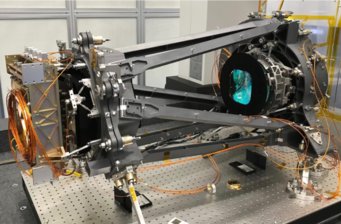Sharp eyes for Euclid
In September, the payload module for the Euclid space telescope passed its final tests and is now ready for integration with the service module. Together with the Euclid telescope, the two instruments VIS and NISP, whose optics were developed and constructed at the Max Planck Institute for Extraterrestrial Physics, delivered sharp images after a simulated rocket launch. The Euclid mission is scheduled to launch into space in 2022 to study the “dark universe”.

“The instruments work and the image is sharp,” Frank Grupp summarizes the tests on the Euclid payload module. The scientist at the Max Planck Institute for Extraterrestrial Physics (MPE) and the University Observatory Munich is the German project manager and responsible for the optics of NISP, one of the two instruments for the Euclid space telescope. The mission of Euclid is to shed light on the question of how the universe has evolved over the last ten billion years by investigating the “dark side” of the universe.
Euclid consists of a 1.2m diameter telescope and two instruments, VIS and NISP. Over the six-year mission, VIS will observe the shape of galaxies in visible light, while NISP will measure the distance of galaxies at near-infrared wavelengths. With these two pieces of information, the three-dimensional distribution of galaxies in the sky as well as the minuscule distortion of the shape of these galaxies caused by gravity, the Euclid space telescope will investigate questions about dark matter and the nature of mysterious dark energy (link to Nobel Prize 2011 and 2019) after its launch in late 2022.

As partner of the Euclid project, MPE is responsible for the optical components of the NISP instrument as well as for the optical design and modelling of the image quality. With diameters of about 20cm, the lenses installed in NISP are the largest and by far the most precise optics ever intended for launch in a satellite in civil space exploration.
“We are all pleased and happy that our NISP came through the tests well, especially the vibration tests to simulate the rocket launch,” says Frank Grupp. “Under realistic conditions, i.e. replicating cold, airless space in the test chamber, it produces a good image together with the telescope.”
After the successful tests, the payload module consisting of the telescope and the two instruments is currently being packed and prepared for shipment to Italy. There it will be connected to the service module, which will provide the on-board computers, attitude control of the spacecraft and communication with the ground stations.
Then, in late 2022, Euclid will launch on the tip of a Soyuz rocket from the French spaceport in Kourou and begin its journey to the outer Lagrange Point 2 of the Sun-Earth system, 1.5 million kilometres from Earth. “These were the last images from our instrument before Euclid will open its eyes in space,” adds Frank Grupp. “We are excited and eagerly awaiting the first images of the real sky.”
More information:
The Euclid consortium consists of scientists from about 15 countries, including Germany. The Max Planck Institute for Extraterrestrial Physics in Garching, the Max Planck Institute for Astronomy in Heidelberg, the University of Bonn and the Ludwig Maximilians University in Munich are involved both in developing some of the hardware and software for one of the two scientific instruments on board (NISP) and in handling the scientific data.













